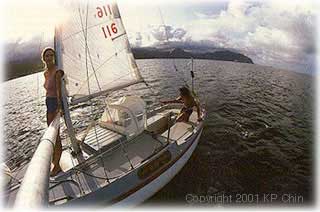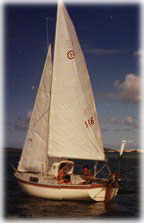
Expand Your Pocket Cruiser's Horizons
by K.P. Chin

"Chalupa" sailing Kaneohe Bay, Hawaii
After sailing Chalupa, my Cal 20, from San Francisco, California, to Kauai, Hawaii in 1980 (see story in Cruising World Magazine, December 1981), I have met several small-boat sailors interested in the preparations of my boat for ocean crossing. This article is aimed at small-boat sailors in general and Cal 20 owners in particular who wish to modify their boats for ocean sailing.
The Bill Lapworth-designed Cal 20 made its first appearance in Southern California in 1961. With ample cockpit space, an easily handled jib, room to sleep four and an affordable price, it soon became popular with small boat racers and cruisers alike. Many were built and class associations sprang up all across the East Coast and West Coast including Hawaii.
I chose a Cal 20 for my solo voyage because I had confidence in them, having raced regularly on one in San Francisco Bay and also they were seaworthy and affordable. Cal 20s were not built to cross oceans however,but I figured with some modifications she will do all right. As it turned out Chalupa successfully, carried me safely across some 2,400 miles of the Pacific Ocean through three days of calms and six days and nights of gales during the 20-day trip.
Since then I have lived on board and cruised more than 1,000 miles among the Hawaiian Islands without major problems. This is what I have done to make her the cruiser she is today.
Cal 20s hulls were considered to be soundly built, which was typical of the early fiberglass production boats. But since she was designed primarily as a coastal sailor, I did some modifications to strengthen the hull and rig and to make her easier to singlehand.
A full-length foam/wood interior stringer was glassed in from bow to transom on either side of the hull. The leaky glass portlights were replaced with 1/8-inch Lexan and thru-bolted. The bulkhead directly under the mast step was stiffened with 3/4-inch marine plywood strips three inches wide and thru-bolted; this spread the mast compression load more evenly. New stainless steel keel bolts were installed along with extra large washers. A sliding wood main hatch cover was added to prevent seawater from coming into the cabin from under the sliding hatch, and to provide a support for the tiny canvas spray dodger. This item proved invaluable. At times when the boat surfed down waves and scooped up a small waterfall of seawater into the cockpit, I would be dry under the dodger.
A bow pulpit, lifelines and stanchions were installed. Teak grab rails along each side of the foredeck gave me a solid hand and foot hold forward, and a place to lash down a headsail.
One of the first things I did when I bought the boat was to take out the head and replace it with a more durable, efficient and odorless plastic bucket. Suddenly extra storage space materialized. This also gave me just one thru-hull opening on the entire boat, the electronic knot meter impeller unit that was reinforced with plenty of good caulking.
The aging rudder was replaced by a new, stronger one with heavy-duty pintles and gudgeons.
The original 11x14 inch cockpit engine well aft was retained and large holes were drilled through the top cover to create a very efficient cockpit drain. A plywood platform was built over it for life raft storage, without obstructing any water flow. The space occupied by the life raft reduced the large cockpit volume by about 40 percent. In heavy weather conditions there was always some seawater sloshing around the cockpit floor, but never more than two to three inches.
The only lazarette cover was always secured and taped shut when sailing in open water. As there is no forehatch, the only way for water to get inside would be through the companionway. However, should the cabin be flooded, a 10-gallon-per-minute Whale pump, backed up the foolproof plastic bucket, was always handy.
Because the original mast and boom were old and showed signs of corrosion, they were replaced along with the hinged mast step. Although the standard fractional rig sail configuration was kept, all hardware from spreader brackets to masthead fitting cap were substituted with heavier gauge models.
The stainless steel headstay, backstay, all shrouds and turnbuckles were upgraded to the next larger size, with the old ones kept aboard as emergency spares.
On the original Cal 20, the aft lower shrouds were attached directly to the deck which tended to lift the deck when under heavy loading. This was corrected by reinforcing the under side of the deck with stainless steel straps and turnbuckles that were bolted to the hull from below. Large backing plates anchored all deck fittings.
Two 1/2-inch Dacron lines (now I would prefer nylon webbing instead) secured at the midship stanchions and the bow pulpit served as jack lines for my safety harness. They saved my life at least a couple of times.
All running rigging were led aft from the base of the mast through turning blocks to cam cleats mounted beside the jib sheet winches on either side of the deck. An extra jib halyard was added for flying twin headsails. The topping lift also served as an extra main halyard, should I loose the original.
For self-steering I chose a Navik windvane. A sheet-to tiller arrangement described in John Letcher's book, Self-Steering For Sailing Craft, was used as a backup.
By rigging the boat myself, I inspected and became familiar with how each item was installed. Without an engine, I intended to sail myself out of most situations, so I put my money on the rig and a pair of eight-foot oars. These served as auxiliary power in harbors and on windless days.
Chalupa carried six sails: mainsail, two jibs, genoa, storm jib and cruising spinnaker. Even under double-reefed main and storm jib, she was over canvassed in Force 6 winds and above ( I now have a third-set of reef points in the mainsail, although a small trysail would be preferable). The 40-square-foot storm jib allowed her to point and make headway in heavy weather without excessive slamming. With wind anywhere from a broad reach to dead run and 10 knots or less, the spinnaker was truly a morale and mile booster. On a beam reach and above in light air, I used the 150 percent genoa. All sails were triple-stitched.
There are countless pieces of gear and spares that would be nice to have on a voyage, but due to the rather light load-carrying capability of Chalupa, I had to limit items to only those most essential. Even then, I tried to take equipment that served more than one purpose.
For celestial navigation I had an old bronze micrometer sextant and a spare plastic one. When using the plastic sextant, I was careful not to expose it to the tropical sun for too long because the plastic will expand in the heat. My shortwave AM/FM receiver provided entertainment and Greenwich Mean Time. A small quartz timepiece was taken along as a backup.
To cut down on weight, I avoided carrying thick navigational books and Pilots by making copies of only the relevant pages. A current Nautical Almanac and the very compact H.O. 208 sight reduction tables were used.
To conserve electricity, the tricolor running light at the masthead was turned on at night only when I was taking my hourly nap.
At the time of my trip, the cost of a reasonable life raft was beyond my already limited budget. So, I borrowed a Avon dinghy with a protective canopy and added carbon dioxide bottles for quick inflation. The Avon's standard nylon carrying bag was modified so that the lashing could be quickly opened by pulling on a single cable. The rest of the emergency gear consisted of an EPIRB, flares, a prepacked survival kit, water and life jacket.
One item that I came to appreciate more than any other after a year of cruising was the solar battery charger. It took care of all my electrical needs, knot/log meter, running lights, compass light and cabin lights without having to move the heavy battery ashore for charging every few weeks or so.
I started off the voyage with an eight pound Danforth anchor plus 15 feet of 1/4-inch chain, and 150 feet of 7/16-inch nylon line to save weight. I now also carry an 18-pound CQR and another Danforth with more chain and line. I made it a habit to dive and set my anchor and to tie a float to the shackle where the chain meets the nylon line, to prevent chaffing over a coral or a rocky bottom. This of course added extra weight, but for peace mind it was acceptable.
Other essential gear included a sail repair kit, first-aid kit, wire cutter, a basic toolbox, Nicopress tool and an assortment of spare hardware.
For commuting ashore I used a small two-person rubber dinghy, which was partially inflated in the forepeak when under way for additional flotation.
My provisioning for the crossing was based on the assumption that I would be at sea from 20 to 30 days. My water allowance was about a half-gallon per day, though I actually took 18 gallons plus a solar still for emergencies. The water was stowed in one-gallon collapsible plastic containers under the cockpit floor. There was also plenty of liquid in the canned vegetables and fruits. The labels were removed from the cans, marked and then varnished over to prevent rusting.
I was careful to use the water only for drinking and cooking, and as it turned out, I still had eight gallons left when I arrived in Kauai.
All food and equipment that had to be kept dry and free from rust was put into airtight plastic buckets. In case of interior flooding, they would also become partial flotation.
Aft of the main bulkhead on the port side of the cabin I built a small galley with a gimbaled butane cartridge stove. For inter-island cruising I now use a Coleman two-burner camping stove using white gas. It burns hotter, easily available and less expensive than butane bottles.
Lying on either quarter berth, I could check my compass heading without rising by watching the two-way compass fixed to the permanently placed companionway drop board.
Three flotation cushions served as pillows. I carried no mattresses because they tend to soak up water, will not dry out properly and add weight. A couple of light closed-cell foam pads worked fine for me.
A flexible chart light serves as cabin and cooking light, with a small kerosene lamp as backup.
Extra storage bins were created by cutting out one side of a rectangular plastic tub and mounting it edge-first against a bulkhead. Besides being cheap, light and easy to install, they are also water, rust and injury-proof.
Taking a small boat designed primarily for coastal sailing across an ocean required some compromises. I accepted that. But after a year of cruising I do not think that I could find another similarly sized boat that would provide me with all the fun and joy of cruising at a price I could afford at the time.
Human, basically a creature of the land finds that comfort in a small boat is relative. Space in a boat is used more intensely. Inside Chalupa I move very little; all my cooking, eating, reading and navigating is practically done from one spot.
Voyaging in small craft may not be for everyone, but for those who want to do it badly enough and only have a very limited budget, it's definitely feasible. An attitude of how little one needs, rather than how much one wants, is required.

* * *
First published in Cruising World Magazine, September 1985.
Copyright 1996 KP Chin.
All rights reserved.
Return to CruiseWeb HomePage